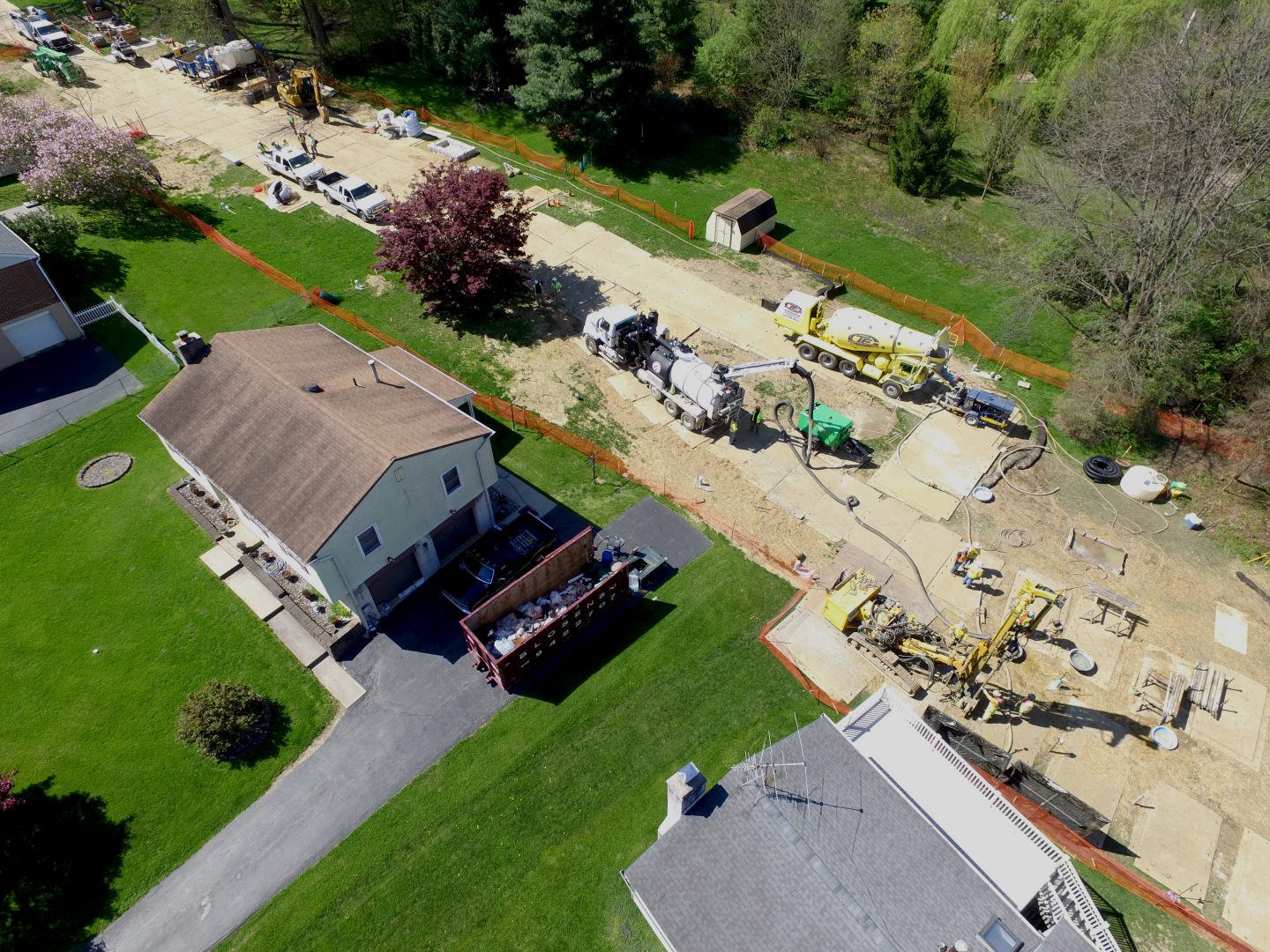
Mariner East 2 pipeline construction crews respond to sinkholes in the backyards of homes on Lisa Drive in West Whiteland Township, Chester County.
Marie Cusick / StateImpact Pennsylvania


Mariner East 2 pipeline construction crews respond to sinkholes in the backyards of homes on Lisa Drive in West Whiteland Township, Chester County.
Marie Cusick / StateImpact Pennsylvania

Marie Cusick / StateImpact Pennsylvania
Mariner East 2 pipeline construction crews respond to sinkholes in the backyards of homes on Lisa Drive in West Whiteland Township, Chester County.
The Public Utility Commission is the agency that decided on Sunoco’s public utility status for building the Mariner East pipelines, which include Mariner East 1, 2, and 2X.
The status allows Sunoco to take land through eminent domain for their 350-mile long pipeline that will carry natural gas liquids across the state to an export terminal in Delaware County.
Sunoco says its plans include terminals to offload natural gas liquids for domestic use as well, but it’s unclear how much and what it would be, and how it would be used.
Sunoco’s power to use eminent domain in this case goes all the way back to a 1930 decision made by the Pennsylvania Public Service Commission, a precursor to the state Public Utility Commission, which granted the Susquehanna Pipe Line Company a “Certificate of Public Convenience,” meaning it would be considered a public utility.
That certificate granted the company permission to build a pipeline to transport gasoline from Philadelphia area refineries to western counties.
It’s unclear if the Susquehanna Pipe Line Company ever used eminent domain to construct the original line. But the 8-inch pipeline still exists, and Sunoco Logistics now owns the line, which it retrofitted to ship natural gas liquids from the Marcellus Shale to southeastern Pennsylvania.
The company reversed the flow on that 8-inch line, renamed it the Mariner East pipeline, and shipments of the natural gas liquid ethane began leaving the Port of Philadelphia for Scotland in March 2016.
Sunoco’s expanded $2.5 billion Mariner East 2 includes two 24-inch diameter lines that will carry ethane, butane and propane through 2,700 properties in Ohio and Pennsylvania.
The Mariner East 2x is a 16-inch line. Sunoco argues that the original certificate, combined with recent certificates of public convenience it received from the Public Utility Commission to expand the Mariner East 1 pipeline in Washington County, give it the power of eminent domain.
The Public Utility Commission, in a brief to the courts, defended its decision to grant the certificate of public convenience, but takes no position on whether Sunoco’s use of eminent domain in this case is legitimate — although without the PUC’s certificate of public convenience, Sunoco would not have eminent domain authority.
For the most part, the company’s legal arguments have worked. Courts in western and central Pennsylvania have been consistently ruling in Sunoco’s favor and against landowners.
But courts in both York and Philadelphia counties have questioned that 86-year-old decision, raising issues as to whether the company is engaged in interstate commerce, and whether it should enjoy status as a public utility.
Some eminent domain attorneys say the issue may not be resolved until it reaches the state Supreme Court. If so, it will be the job of court to decide just how broad the power of eminent domain is in the state, and how the public good is defined.
Sunoco secured 50-foot easements from the majority of property owners. The state Supreme Court recently rejected taking a handful of appeals cases, but it could ultimately decide to rule on one, several, or none of them.
In the meantime, construction is not impeded by the ongoing litigation.
Regarding the governor’s position, Wolf says he agrees in principle to conducting a risk assessment of the line, but he says it would be up to the Public Utility Commission. The PUC has not made a decision either way.
StateImpact Pennsylvania is a collaboration among WITF, WHYY, and the Allegheny Front. Reporters Reid Frazier, Rachel McDevitt and Susan Phillips cover the commonwealth’s energy economy. Read their reports on this site, and hear them on public radio stations across Pennsylvania.
(listed by story count)
StateImpact Pennsylvania is a collaboration among WITF, WHYY, and the Allegheny Front. Reporters Reid Frazier, Rachel McDevitt and Susan Phillips cover the commonwealth’s energy economy. Read their reports on this site, and hear them on public radio stations across Pennsylvania.
Climate Solutions, a collaboration of news organizations, educational institutions and a theater company, uses engagement, education and storytelling to help central Pennsylvanians toward climate change literacy, resilience and adaptation. Our work will amplify how people are finding solutions to the challenges presented by a warming world.